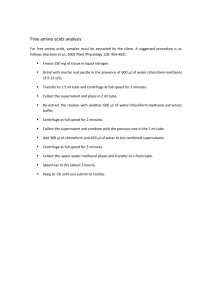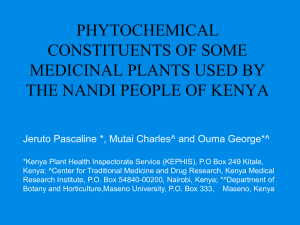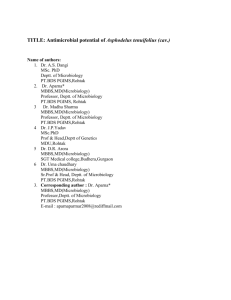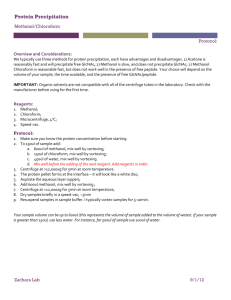Tylosema fassoglensis Torre & Hillc (Caesalpiniaceae)
advertisement
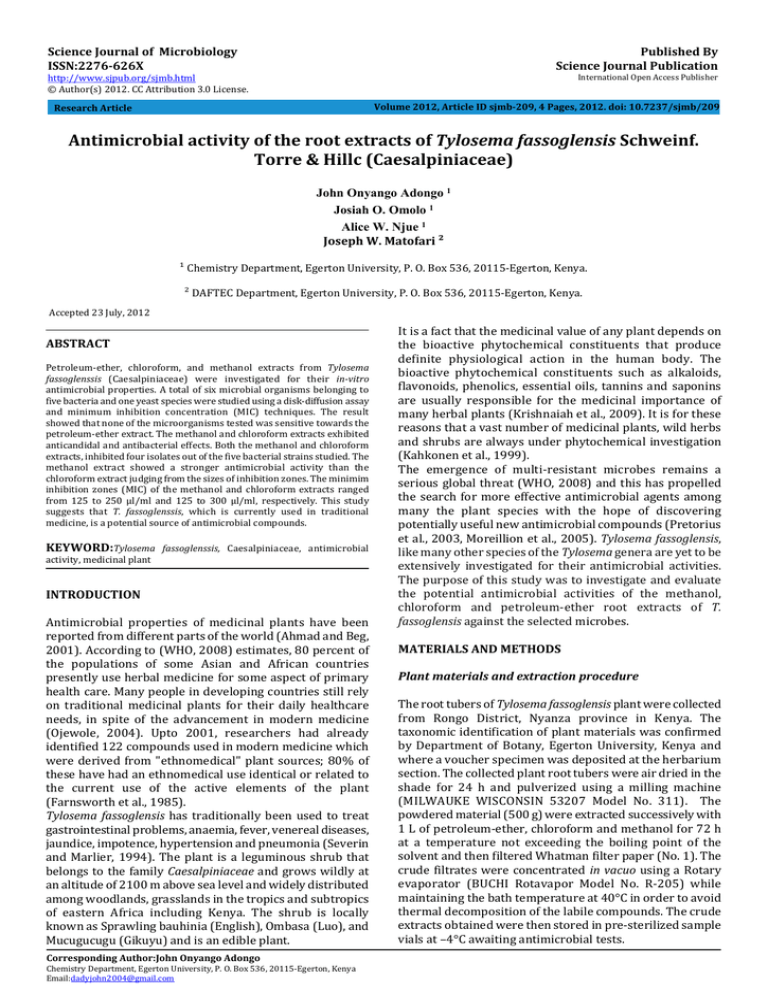
Published By Science Journal Publication Science Journal of Microbiology ISSN:2276-626X International Open Access Publisher http://www.sjpub.org/sjmb.html © Author(s) 2012. CC Attribution 3.0 License. Volume 2012, Article ID sjmb-209, 4 Pages, 2012. doi: 10.7237/sjmb/209 Research Article Antimicrobial activity of the root extracts of Tylosema fassoglensis Schweinf. Torre & Hillc (Caesalpiniaceae) John Onyango Adongo 1 Josiah O. Omolo 1 Alice W. Njue 1 Joseph W. Matofari ² ¹ Chemistry Department, Egerton University, P. O. Box 536, 20115-Egerton, Kenya. ² DAFTEC Department, Egerton University, P. O. Box 536, 20115-Egerton, Kenya. Accepted 23 July, 2012 ABSTRACT Petroleum-ether, chloroform, and methanol extracts from Tylosema fassoglenssis (Caesalpiniaceae) were investigated for their in-vitro antimicrobial properties. A total of six microbial organisms belonging to five bacteria and one yeast species were studied using a disk-diffusion assay and minimum inhibition concentration (MIC) techniques. The result showed that none of the microorganisms tested was sensitive towards the petroleum-ether extract. The methanol and chloroform extracts exhibited anticandidal and antibacterial effects. Both the methanol and chloroform extracts, inhibited four isolates out of the five bacterial strains studied. The methanol extract showed a stronger antimicrobial activity than the chloroform extract judging from the sizes of inhibition zones. The minimim inhibition zones (MIC) of the methanol and chloroform extracts ranged from 125 to 250 µl/ml and 125 to 300 µl/ml, respectively. This study suggests that T. fassoglenssis, which is currently used in traditional medicine, is a potential source of antimicrobial compounds. KEYWORD:Tylosema fassoglenssis, Caesalpiniaceae, antimicrobial activity, medicinal plant INTRODUCTION Antimicrobial properties of medicinal plants have been reported from different parts of the world (Ahmad and Beg, 2001). According to (WHO, 2008) estimates, 80 percent of the populations of some Asian and African countries presently use herbal medicine for some aspect of primary health care. Many people in developing countries still rely on traditional medicinal plants for their daily healthcare needs, in spite of the advancement in modern medicine (Ojewole, 2004). Upto 2001, researchers had already identified 122 compounds used in modern medicine which were derived from "ethnomedical" plant sources; 80% of these have had an ethnomedical use identical or related to the current use of the active elements of the plant (Farnsworth et al., 1985). Tylosema fassoglensis has traditionally been used to treat gastrointestinal problems, anaemia, fever, venereal diseases, jaundice, impotence, hypertension and pneumonia (Severin and Marlier, 1994). The plant is a leguminous shrub that belongs to the family Caesalpiniaceae and grows wildly at an altitude of 2100 m above sea level and widely distributed among woodlands, grasslands in the tropics and subtropics of eastern Africa including Kenya. The shrub is locally known as Sprawling bauhinia (English), Ombasa (Luo), and Mucugucugu (Gikuyu) and is an edible plant. Corresponding Author:John Onyango Adongo Chemistry Department, Egerton University, P. O. Box 536, 20115-Egerton, Kenya Email:dadyjohn2004@gmail.com It is a fact that the medicinal value of any plant depends on the bioactive phytochemical constituents that produce definite physiological action in the human body. The bioactive phytochemical constituents such as alkaloids, flavonoids, phenolics, essential oils, tannins and saponins are usually responsible for the medicinal importance of many herbal plants (Krishnaiah et al., 2009). It is for these reasons that a vast number of medicinal plants, wild herbs and shrubs are always under phytochemical investigation (Kahkonen et al., 1999). The emergence of multi-resistant microbes remains a serious global threat (WHO, 2008) and this has propelled the search for more effective antimicrobial agents among many the plant species with the hope of discovering potentially useful new antimicrobial compounds (Pretorius et al., 2003, Moreillion et al., 2005). Tylosema fassoglensis, like many other species of the Tylosema genera are yet to be extensively investigated for their antimicrobial activities. The purpose of this study was to investigate and evaluate the potential antimicrobial activities of the methanol, chloroform and petroleum-ether root extracts of T. fassoglensis against the selected microbes. MATERIALS AND METHODS Plant materials and extraction procedure The root tubers of Tylosema fassoglensis plant were collected from Rongo District, Nyanza province in Kenya. The taxonomic identification of plant materials was confirmed by Department of Botany, Egerton University, Kenya and where a voucher specimen was deposited at the herbarium section. The collected plant root tubers were air dried in the shade for 24 h and pulverized using a milling machine (MILWAUKE WISCONSIN 53207 Model No. 311). The powdered material (500 g) were extracted successively with 1 L of petroleum-ether, chloroform and methanol for 72 h at a temperature not exceeding the boiling point of the solvent and then filtered Whatman filter paper (No. 1). The crude filtrates were concentrated in vacuo using a Rotary evaporator (BUCHI Rotavapor Model No. R-205) while maintaining the bath temperature at 40°C in order to avoid thermal decomposition of the labile compounds. The crude extracts obtained were then stored in pre-sterilized sample vials at –4°C awaiting antimicrobial tests. Page 2 Science Journal of Microbiology (ISSN:2276-626X) Microorganisms A total of six microorganisms, one yeast species, and five bacterial species, were used in this study. The list of microorganisms used is given in Tables 1. The microorganisms were obtained from the Dairy and Food science Technology (DAFTEC) Department of Egerton University, Kenya. Antimicrobial activity The stored crude extracts were dissolved in their respective solvents (methanol, chloroform and petroleum-ether) to a final concentration of 30 mg/ml using 0.45 µm milipore filters. Antimicrobial tests were then carried out by disk diffusion method (Murray et al., 1995) using 100 µl of suspension containing 108 CFU/ml of bacteria, 106 CFU/ml of yeast spread on nutrient agar (NA) and sabouraud dextrose agar (SDA) respectively. The disks (6 mm in diameter) were impregnated with 10 µl of the extracts (300 µg/disk) at the concentration of 30 mg/ml and placed on the inoculated agar. Negative controls were prepared using the same solvents employed to dissolve the plant root extracts. Penicillin-G (10 µg/disk) was used as a positive reference standard. The inoculated plates were incubated at 30⁰C for 24 h for bacterial strains, and 48 h for yeast isolates. Antimicrobial activity was evaluated by measuring the zone of inhibition against the test organisms. Each assay in this experiment was repeated five times. Microdilution assay The minimal inhibitory concentration (MIC) values were also studied for the microorganisms which were determined as sensitive to the extracts in the disk diffusion assay. The inocula of the microorganisms were prepared from 12 h broth cultures and suspensions were adjusted to 0.5 McFarland standard turbidity. The T. fassoglensis extracts dissolved in 10% dimethylsulfoxide (DMSO) were first diluted to the highest concentration (600 µg/ml) to be tested, and then serial two-fold dilutions were made in a concentration range from 9.37 to 600 µg/ml in 10 ml sterile test tubes containing nutrient broth. The MIC values of T. fassoglensis extracts against the five bacterial strains and C. albicans isolates were determined based on a micro-well dilution methd (Zgoda and Porter, 2001) with some modifications. The 96-well plates were prepared by dispensing into each well 95 µl of nutrient broth and 5 µl of the inoculum. A 100 µl from T. fassoglensis extracts initially prepared at the concentration of 600 µg/ml was added into the first wells. Then, 100 µl from their serial dilutions was transferred into six consecutive wells. The last well containing 195 µl of nutrient broth without compound and 5 µl of the inoculum on each strip was used as negative control. The final volume in each well was 200 µl of Maxipime (Bristol-Myers Squibb) at the concentration range of 500 - 10 µg/ml was prepared in nutrient broth and used as standard drug for positive control. The plate was covered with a sterile plate sealer. Contents of each well were mixed on plate shaker at 300 rpm for 20 s and then incubated at appropriate temperatures for 24 h. Microbial growth was determined by absorbance at 600 nm using the ELx 800 universal microplate reader (Biotek Instrument Inc., Highland Park, Vermont, USA) and confirmed by plating 5 µl samples from clear wells on nutrient agar medium. The extract tested in this study was screened in five replicates times against each organism. The MIC was defined as the lowest concentration of the compounds to inhibit the growth of microorganisms. RESULTS AND DISCUSSION The antimicrobial activities of Tylosema fassoglensis (petroleum-ether, chloroform and methanol) extracts against the microorganisms (Candida albicans, Bacillus cereus, Salmonella typhimurium, Staphylococcus aureus, Escherichia coli, Bacillus subtilis) were examined in the study. Their potency, were qualitatively and quantitatively assessed by the presence or absence of inhibition zones, zone diameters, and the MIC values. The antimicrobial activity results are given in Table1. The determine MIC values for the pathogens are reported in table 2. The results indicate that both methanol and chloroform extracts of T. fassoglensis have some anticandidal properties while the petroleum-ether extract has none. The results also showed that methanol extract of T. fassoglensis has an antimicrobial effect against four out of the five bacterial strains tested i.e. B. cereus, S. aureus, E. coli and B. subtilis. On the other hand, the petroleum-ether extract showed no antibacterial activity. The chloroform extract exhibited antimicrobial effect against B. cereus, S. typhimurium, S. aureus and B. subtilis (tables 1 and 2). Tale 1. Antimicrobial activity of crude extracts of Tylosema fassoglensis Inhibition zone in diameter (mm) around test disk Tylosema fassoglensis extracts (300 μg/disk) Test Organisms Methanol Chloroform Petroleum-Ether C. albicans 13±1.2 10±1.3 – B. cereus 12±1.1 8±1.1 – – 7±0.9 S. typhimurium S. aureus 12±1.4 E. coli 15±1.5 B. Subtilis 12±1.2 11±1.2 – 8±1.1 – – – – Positive Control (10 μg/disk) - (NET) 30(OFX) 27(SCF) 22(SCF) NT 28(0FX) Key: (-)=Nil, OFX=Ofloxacin (10 µg/disk); SCF=sulbactam (30 µg)+cefoperazona (75µg) (105 µg/disk); NET=Netilmicin (30 µg/disk) were used as positive reference standards antibiotic disks (Oxoid); NT=Not tested. How to Cite this Article: John Onyango Adongo, Josiah O. Omolo, Alice W. Njue, Joseph W. Matofari“Antimicrobial activity of the root extracts of Tylosema fassoglensis Schweinf. Torre & Hillc (Caesalpiniaceae)” Science Journal of Microbiology, Volume 2012, Article ID sjmb-209, 3 Pages, 2012. doi: 10.7237/sjmb/209 Science Journal of Microbiology (ISSN:2276-626X) Page 3 The maximum inhibition zones and MIC values for C. albicans isolates for methanol and chloroform extracts were in the range of 10-13 mm and 250-300 µl/ml respectively. The maximal inhibition zones and MIC values for bacterial strains for the methanol and chloroform extracts were in the range of 7-15 mm and 125-250 µl/ml respectively (tables 1and 2). Three gram positive bacterial strains (B. cereus, S. aureus, and B. subtilis) were sensitive to both the methanol and chloroform crude extracts. The gram negative (E. coli) was sensitive to the methanol extract while the gram negative (S. typhimurium) was sensitive to the chloroform extract. This result suggests that the antimicrobial compounds that target the gram positive bacteria do not necessarily also target the gram negative bacteria. Table 2. The MIC values of Tylosema fassoglensis extracts against the microorganisms (MIC in µg /ml). Tylosema fassoglensis extracts (300 μg/disk) Test Organisms Methanol Chloroform Petroleum-Ether C. albicans 250 300 – Standard Drug (Maxipime) 500 B. cereus 125 250 – 250 – 125 – 62.50 S. aureus 125 250 – 15.625 E. coli 175 – – 125 B. subtilis 125 250 – 250 S. typhimurium In the case of the methanol extract, the maximal inhibition zones and MIC values of the bacterial strains were 12-15 mm and 125-250 µl/ml, respectively (Tables 1 and 2). Based on these results, the methanol extract had a stronger antimicrobial activity compared with the chloroform extract. The compounds responsible for the anti-microbial activity in the crude extracts are somewhere between mid-polar and very polar compounds are very polar compounds. This is because petroleum-ether, which is the least polar of the three solvents, showed no anti-microbial activity. REFERENCES 1. Ahmad I, Beg AZ (2001). Antimicrobial and phtytochemical studies on 45 Indian medicinal plants against multi-drug resistant human pathogens. Journal of Ethnopharmacology 74: 113-123. 2. Farnsworth NR, Akerele O, Bingel AS, Soejarto DD and Guo ZG (1985). Medicinal plants in Therapy. Bulletin World Organization 63, 965-981. 3. Kahkonen PM, Hopia IA, Vuorela JH, Rauha JP, Pihlaja K, Kujala ST and Heinonen M (1999). Antioxidant activity of plant extracts containing phenolic compounds. Journal of Agriculture and Food Chemistry 47: 3954-3962. 4. Krishnaiah, D, Devi T, Bono, A and Sarbatly A (2009). Studies on phytochemical constituents of six Malaysian medicinal plants. Journal of Medicinal Plants Research 3: 67-72. The results of this study suggest that T. fassoglensis extracts possesses compounds with antimicrobial properties against C. albicans, and some bacterial pathogens. Its observed antimicrobial activity provides an explanation for its use in traditional folk medicine. Considering that the plant has beneficial antimicrobial activities, it can be cultivated for use as a potential source of anti-antibacterial and antifungal compounds. 5. Murray PR, Baron EJ and Pfaller MA (1995). Manual of Chinical Microbiology 6th Edition. ASM: Washington DC. pp 213-215. 6. Moreillion, P, Que, YA and Glauser, MP (2005). Staphylococcus aureus (Including Staphyloccal Toxic shock). In 'Principles and Practice of Infectious diseases. (Ed.) Mandell G.L, Bennett J.E, Dolin R. Published by Churchill livingstone Pennyslyvania 6th ed. 2: 2333- 2339. 7. Ojewole JAO (2004). Evaluation of the analgesic, anti-inflammatory and anti-diabetic properties of Sclerocarya birrea (A. Rich.) Hochst. Stem bark aqueous extract in mice and rats. Phytotherapy Research 18: 601-608. ACKNOWLEDGEMENTS 8. Pretorius, JC, Magama, S and Zietsman, PC (2003). Growth inhibition of plant pathogenic bacteria and fungi by extracts from selected South African plant species. South African Journal of Botany 20: 188-192. 9. Severin M. and Marlier M (1994). Chemical characterisation of Tylosema fassoglensis (Kotschy) Torre and Hillc. Cyanoglucoside. Journal of the Science of Food and Agriculture 67(2): 163-167. 10. World Health Organization (WHO) (2001). Traditional medicine. Fact sheet number 134. Revised May, 2003. Available on http/www.who.int/media centre fact sheet/fs/134. 11. Zgoda, JR and Porter, JR. (2001). A convenient microdilution method for screening natural products against bacteria and fungi. Pharmaceutical Biology 39: 221-225. CONCLUSIONS We wish to thank technical staff of Chemistry and DAFTEC Departments of Egerton University, Kenya for their technical assistance How to Cite this Article: John Onyango Adongo, Josiah O. Omolo, Alice W. Njue, Joseph W. Matofari“Antimicrobial activity of the root extracts of Tylosema fassoglensis Schweinf. Torre & Hillc (Caesalpiniaceae)” Science Journal of Microbiology, Volume 2012, Article ID sjmb-209, 3 Pages, 2012. doi: 10.7237/sjmb/209
